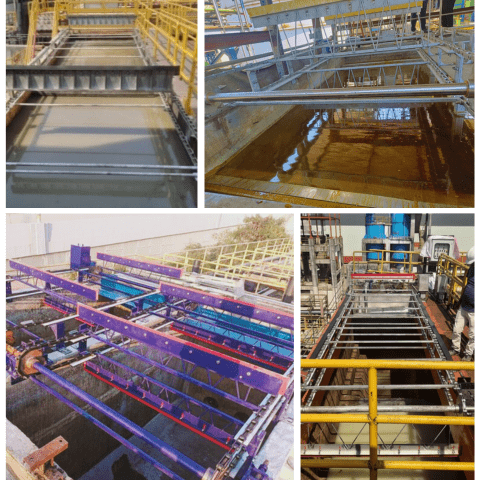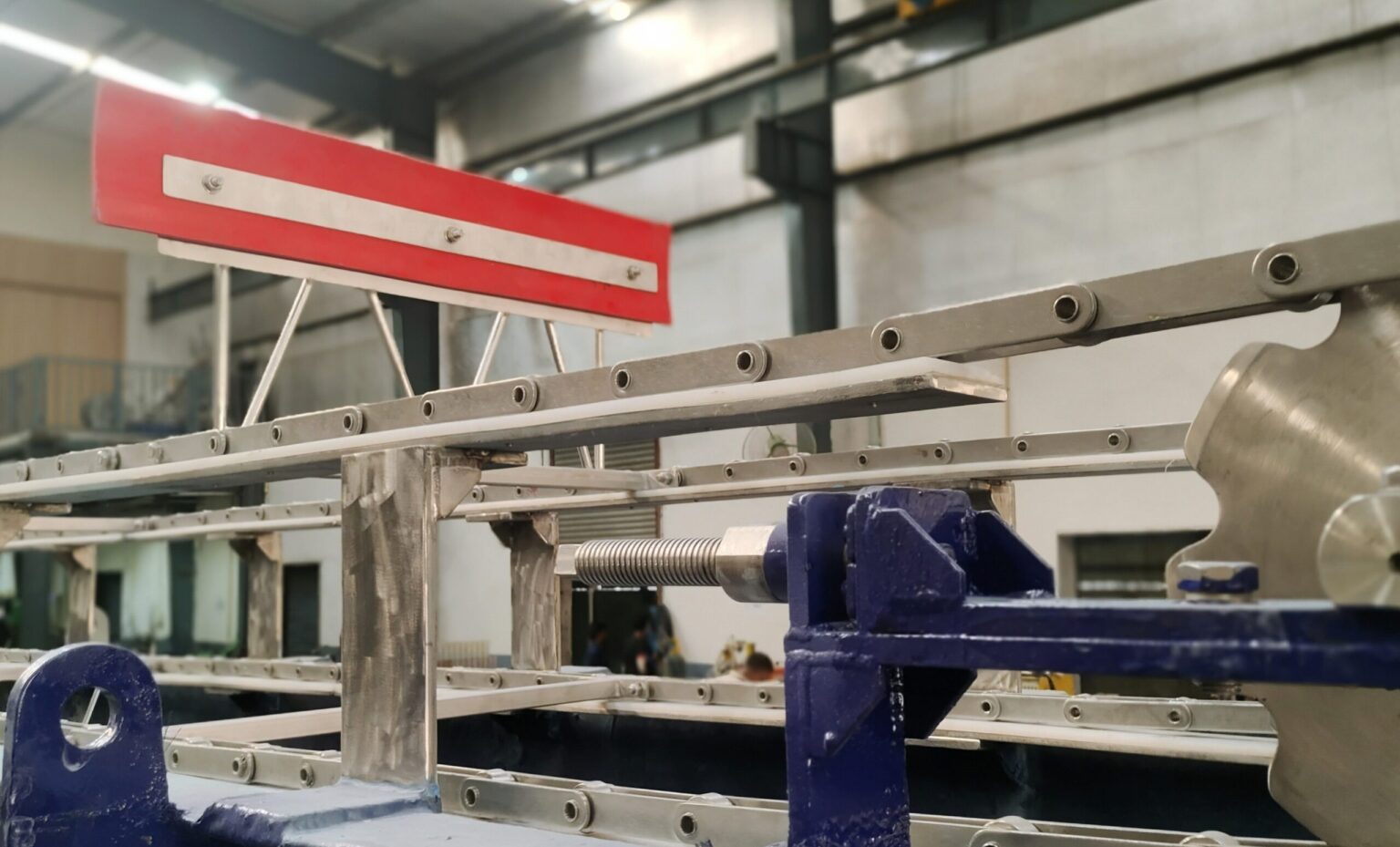Chain Scraper Systems: Enhancing Efficiency with Automation and Advanced Tech

A chain scraper system is a mechanical system commonly used in wastewater treatment (WWT) to remove settled sludge and floating scum from sedimentation tanks or clarifiers. It plays a vital role in primary and secondary treatment processes by ensuring efficient solids separation and sludge handling to maintain and optimize treatment processes.
Over the years, advancements in innovation and technology have led to smart and more efficient chain scraper systems for wastewater treatment plants. The innovations shaping the future of chain scraper technology include:
- 1. Material Improvement
- • New materials are used in chain scraper systems to improve efficiency and lifespan. These include high-performance polymers like HDPE, PU, PA, and POM, reinforced composites such as FRP and GFRP, and corrosion-resistant metals such as 304/316-grade stainless steel, duplex stainless steel, and titanium alloys.
- • Advanced plastics such as HDPE or reinforced composites are replacing traditional metal components. They reduce wear, reduce weight, improve chemical resistance, and minimize maintenance requirements.
- • Corrosion-resistant coatings for metal chains. Specialized coatings, such as ceramic or polymer-based treatments, have proven to enhance durability in harsh environments.
- 2. Energy-Efficient Designs
- • Lightweight components reduce the mass of chains and scrapers thereby reducing energy consumption.
- • Improved dive systems such as variable frequency drives (VFDs) allow precise control of scraper movement, reducing power usage during low-load conditions.
- 3. Modular and Customizable Systems
- • Modular designs make it easier to adapt chain scrapers for specific applications, extending their usability.
- • Customized geometries and chain configurations improve performance in unique tank shapes and sludge compositions.
- 4. Advanced Engineering Techniques
- • Finite Element Analysis (FEA): Used in the design phase to predict stress points and optimize scraper geometry.
- • Additive Manufacturing (3D Printing): Enables rapid prototyping and production of complex, lightweight components tailored to specific operational needs.
- 5. Enhanced Durability for Extreme Environments: Special designs for handling abrasive or high-temperature sludge materials, incorporating alloys or ceramics in high-stress components.
Role of Automation in the Evolution of Chain Scraper Systems
Automation has played a pivotal role in the evolution of chain scraper systems, transforming them from basic mechanical devices into sophisticated, smart solutions that deliver enhanced performance and reliability in wastewater treatment.
IoT integration and AI have aided the functions and enhanced performance of chain scraper systems in several ways, which are:
- 1. Precise Control: Automated systems ensure consistent movement of chains and scrapers, reducing inefficiencies and optimizing sludge and scum removal.
- 2. Dynamic Speed Adjustments: Variable frequency drives (VFDs) allow the system to adapt to varying loads, ensuring energy-efficient operation.
- 3. Condition Monitoring: Sensors track parameters like chain tension, wear, and alignment, identifying potential issues before they cause breakdowns.
- 4. Proactive Maintenance Alerts: Automated notifications prompt timely interventions, minimizing downtime and extending equipment life.
- 5. Smart Scheduling: Systems can operate during optimal times, avoiding energy wastage during low-load periods.
- 6. Energy Optimization Algorithms: AI-based systems fine-tune energy consumption based on real-time operating conditions.
- 7. IoT Integration: Automated chain scraper systems connect to IoT platforms, and allow operators to monitor remotely.
- 8. Remote Diagnostics and Control: Problems can be diagnosed and addressed without requiring on-site inspections, improving response times and reducing labor costs.
- 9. Fault Detection and Prevention: Automated systems detect misalignments, excessive loads, or motor failures early, reducing unexpected stoppages.
- 10. Consistent Performance: Automation eliminates variability due to human error, ensuring steady and reliable operations.
- 11. Performance Analytics: Automated systems collect and analyze operational data, enabling continuous improvement in scraper design and performance.
- 12. Integration with Plant-Wide Systems: Chain scraper data contributes to holistic wastewater treatment process optimization.
- 13. Minimized Manual Intervention: Automation reduces the need for workers to interact with hazardous systems.
- 14. Emergency Response Features: Automated shutdown and alarm systems ensure safe operation during faults.
- 15. Flexible Configurations: Automated systems can be tailored to specific plant needs, allowing for easier upgrades or expansions.
Automation has been instrumental in evolving chain scrapers by improving efficiency, reliability, and safety while reducing costs. Technological advancements and automation have ensured that chain scrapers meet the growing demands of modern wastewater treatment plants, setting the stage for even greater innovation in the future.
Frequently Asked Questions
Q1 How often should a scraper in water treatment be maintained?
A. Regular maintenance is necessary to ensure the scraper in water treatment remains functional. Maintenance tasks include inspecting the scraper for wear, checking for mechanical issues, and cleaning the equipment to prevent buildup that could hinder its operation.
Q2 Why is a brush oil skimmer effective for oil removal?
A. A brush oil skimmer is effective because its rotating brushes continuously collect oil from the surface, efficiently attracting and lifting oil, regardless of water flow or changing conditions.





